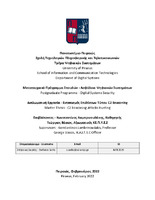Εντοπισμός επιθέσεων τύπου C2 beaconing
C2 beaconing attacks hunting

Master Thesis
Συγγραφέας
Σαρλής, Στέφανος
Sarlis, Stefanos
Ημερομηνία
2022-02Προβολή/
Λέξεις κλειδιά
C2 ; Command and Control ; C&C ; APT ; Beaconing ; Red Teaming ; Covenant ; PowerShell Empire ; Cobalt Strike ; Pupy ; Merlin ; PoshC2 ; AMSI ; Evasion ; Bypass ; RITA ; YARA ; ELK ; Suricata ; Sysmon ; Wazuh ; MITRE ATT&CK ; Attack & Defense Lab ; Dnscat2 ; Oletools ; Capa ; Beacon ; Implant ; Grunt ; Cyber Kill Chain ; Unified Kill Chain ; Callbacks ; Domain Fronting ; Redirectors ; RelaysΠερίληψη
Δεδομένου ότι οι επιθέσεις στον κυβερνοχώρο εξελίσσονται συνεχώς τόσο σε αριθμό όσο και σε πολυπλοκότητα, η χρήση προηγμένων μηχανισμών ασφαλείας καθίσταται επιτακτική. Ωστόσο, παρ’ όλο που οι σύγχρονες λύσεις ασφαλείας προσφέρουν, σε ορισμένες περιπτώσεις, ικανοποιητικά ποσοστά ανίχνευσης, οι απειλές στον κυβερνοχώρο αναπτύσσονται εκθετικά, με αποτέλεσμα να βρίσκονται πάντα σε πλεονεκτική θέση. Επιπλέον, οι παραδοσιακοί μηχανισμοί για τον εντοπισμό κακόβουλης δραστηριότητας μπορούν πολύ εύκολα να παρακαμφθούν, καθώς οι επιτιθέμενοι βρίσκουν συνεχώς νέους και εξεζητημένους τρόπους προκειμένου να αποφύγουν την ανίχνευση από τις εν λόγω λύσεις, στοχεύοντας στη μόλυνση δικτύων και συστημάτων με διαφορετικά είδη κακόβουλου λογισμικού. Επιπρόσθετα, σε αντίθεση με τις λιγότερο πολύπλοκες επιθέσεις, οι Advanced Persistent Threats (APTs) αποτελούν προηγμένες απειλές, στις οποίες οι επιτιθέμενοι διατηρούν χαμηλό προφίλ, εκμεταλλευόμενοι περίπλοκες μεθόδους εισβολής μέσω διαφόρων φορέων επίθεσης. Ένα από τα σημαντικότερα στάδια μιας APT επίθεσης είναι το Command and Control (C2) beaconing. Στα πλαίσια της συγκεκριμένης εργασίας, παρουσιάζεται μια ολιστική προσέγγιση εντοπισμού των beaconing επιθέσεων. Ειδικότερα, αντικείμενο της παρούσας διπλωματικής αποτελεί ο σχεδιασμός και η εκτέλεση πληθώρας σεναρίων επίθεσης, που προσομοιάζουν επιθέσεις τύπου C2 beaconing, με στόχο τη συνδυαστική ανίχνευσή τους. Από την παρούσα εργασία επιβεβαιώνεται ότι ο εντοπισμός της κακόβουλης beaconing συμπεριφοράς απαιτεί το συνδυασμό διαφόρων μηχανισμών ανίχνευσης και ταυτόχρονα την αντιμετώπιση πληθώρας προκλήσεων. Πιο συγκεκριμένα, δεδομένου ότι το beaconing δεν αποτελεί ένα διακριτό συμβάν, αλλά μια ακολουθία χρονικά σχετιζόμενων συμβάντων, είναι πρόδηλο ότι η ανίχνευσή του είναι εξαιρετικά απαιτητική. Επομένως, στη συγκεκριμένη εργασία, μέσω της εκτέλεσης τριών, κλιμακούμενης πολυπλοκότητας, σεναρίων επίθεσης αξιολογείται η αποτελεσματικότητα διαφόρων μεθόδων και λύσεων ασφάλειας, αναφορικά με τον εντοπισμό και τον μετριασμό των εν λόγω επιθέσεων. Τα αποτελέσματα υποδεικνύουν ότι υπάρχουν ακόμη σημαντικά περιθώρια βελτίωσης, καθώς η πλειοψηφία των μηχανισμών ασφαλείας αποτυγχάνει να αποτρέψει σε μεγάλο βαθμό τις συγκεκριμένες απειλές. Ωστόσο, μέσω της συνδυαστικής προσέγγισης που παρουσιάζεται, η ανίχνευση των beaconing επιθέσεων καθίσταται πλέον εφικτή.


